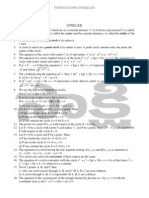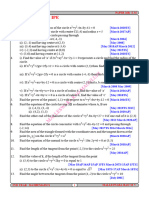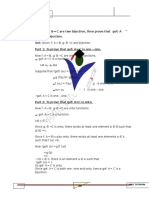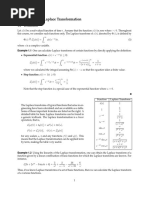Aimstutorial (VSAQ)
Uploaded by
SalmanAnjansAimstutorial (VSAQ)
Uploaded by
SalmanAnjans8.
DIFFERENTIAL EQUATIONS
MATHEMATICS - IIB AIMSTUTORIAL
(VSAQ)
1. Find the order and degree of 4. Find the order and degree of the differential
6/5
d2 y dy 3 1/ 3
2 + = 6y . 1/2 d2 y xdy
dx dx equation x 2 + +y =0.
dx dx
6/5
d2 y dy 3 1/ 3
Sol: Given equation 2 + = 6y 1/2 d2 y xdy
dx dx Sol: x 2 + +y =0
dx dx
3
d2 y dy
2 + = (6y)5/6 1/ 3
dx dx d2 y xdy
Order = 2, Degree = 1. x 1/ 2
2 -y
dx dx
3
d2 y xdy
2. Find the order and degree of the differential x3/ 2 2 - y
dx dx
1/ 4
dy 1/2 d2 y 1/3 Order = 2 degree = 1.
equation + dx 2 = 0 .
dx
1/4
5. Find the order and degree
dy 1/2 d2 y 1/3 2
Sol: Given equation + 2 = 0
2
d3y dy
dx dx
x
3 - 3 - e = 4 .
dx dx
1/2 1/3
dy d2 y 2
dx + 2 = 0 d3 y dy
2
dx
x
Sol: Given equation 3 - 3 - e = 4 .
1/2 1/3 dx dx
dy d2 y Order = 3, Degree = 2.
dx = - 2
dx
3 2
dy d2 y 6. Form the differential equation
dx = - dx 2
corresponding y = ae3x + be4x.
Sol: Given y = ae3x + be4x
Order = 2 degree = 2.
Differenting .w.r.t. ‘x’
y1 = 3ae3x + 4be4x
y2 = 9.ae3x + 16be4x
3. Find the order of the differential equation
5/3
by eliminating a, b from above
2
d y dy 2
2
= 1+ . y e3x e 4x
dx dx y1 3e3x 4e 4x 0
5/3
dy 2 d y
2 y2 9e3x 16e 4x
Sol: Given Differential equation is 2 = 1+
dx dx y 1 1
cubing on both sides y1 3 4 0
3 5
d y
2 dy 2 y2 9 16
2 = 1+ dx y(48 - 36) - 1(16y1 - 4y2) - 11 (9y1 - 3y2) = 0
dx y2 - 7y1 + 12y = 0.
Order of the D.E. is 2.
Degree of the D.E. is 3.
DIFFERENTIAL EQUATIONS :1: 9000687600
MATHEMATICS - IIB AIMSTUTORIAL
7. Form the differnetial equation
corresponding to y = A cos 3x + B sin 3x, 10. Find the order of the differential equation
where A and B are parameters. obtained by eliminating the arbitary
Sol: Given y = A cos 3x + B sin 3x constants a, b from xy = aex + be-x + x2.
Differentiating w.r.t. x, Sol: Given xy = aex + be-x + x2
dy Differenting.wr.t ‘x’
= -3A sin 3x + 3B cos 3x dy
dx x +y = aex - be-x + 2x.
Differentiating again w.r.t. x, dx
2
d y Again Differenting.wr.t. ‘x’
2 = -9A cos 3x - 9 B sin 3x d2 y dy dy
dx x
= -9(A cos 3x + B sin 3x) 2 + (1) + = aex + be-x + 2.
dx dx dx
= -9y
Required differential equation is d2 y 2dy
x + = xy - x2 + 2
d y
2
dx 2 dx
2 + 9y = 0. Hence the order = 2.
dx
8. Form the differential equation of the family 11. Form the differential equation corresponding
of all circles with their centres at the origin to y = cx - 2c2, where c is a parameter.
and also find its order.
Sol: Given y = cx - 2c2 ---------- (1)
Sol: Equation of circle iwth center (0, 0)
and radius r is diff.w.r.to x.
x2 + y2 = r2 ...................... (1)
differenting w.r.to x dy
=c.1-0
dx
dy
2x + 2y =0
dx dy
c=
dy dx
y +x=0 Substituting in (1)
dx
This is the D.E. whose solution is (1) dy dy
2
The order of D.E is 1. y= x - 2 .
dx dx
9. Obtain the differential equation
corresponding to family of rectangular
hyperbolas which have the coordinate dy
12. Solve = e x + y.
axes as asymptotes. dx
Sol: The equation of family of rectangular hyperbolas dy
which have the coordinate axes as asymptotes is Sol: Given = ex + y = e x . e y
dx
xy = c2 dy
Differenting with respect to ‘x’ = ex . dx
ey
dy
x + y (1) = 0 e-y . dy = ex dx
dx
dy on integration,
x +y=0
dx
is the required differential equation. -y x
e dy = e dx
e-y
= ex + c
-1
ex + e-y + c = 0.
DIFFERENTIAL EQUATIONS :2: 9000687600
MATHEMATICS - IIB AIMSTUTORIAL
2
y12 y12
13. Find the integrating factor of y = 4y x 4y .
dy
+ y tanx = sinx by transforming it into 16. Find order and degree of the differential
dx
linear form. d2 y 2dy dy
equation + + y = log + 2 .
dx 2
dx dx
dy
Sol: + y tanx = sinx
dx d2 y 2dy dy
Sol: Given + + y = log + 2
This is linear equation in ‘y’, in the form of dx 2
dx dx
dy Order = 2 degree is not defined.
+ Py = Q.
dx
P = tan x dy
p dx
17. Find the general solution of x + y = 0.
Integration of factor = e dx
dy
= etan x dx Sol: Given equation x + y = 0.
dx
= elog|sec x| x . dx + y dy = 0
sec x. on integration,
x.dx + y.dy = 0
dy x2 y2
14. Find the integrating factor of x -y=2x2 sec2 2x + =c
dx 2 2
by transforming it into linear form. x2 + y2 = 2c.
dy
Sol: x - y = 2x2 sec2 2x x 18. Find the general solution of
dx
dy 1 1 - x 2 dy + 1 - y2 dx = 0 .
- y = 2x sec2 2x.
dx x
This is linear equation in ‘y’, in the form of Sol: Given 1 - x 2 dy + 1 - y 2 dx = 0
dy
+ Py = Q. 1 - x 2 dy = - 1 - y 2 dx
dx
1 dy dx
P= - , Integrating factor = eP dx =-
x 1- y 2
1 - x2
e x dx on integration,
1
e-log x 1 1
1
dy = - dx
2
e log x
1- y 1 - x2
1 sin-1y = -sin-1x + c
= x-1 = .
x sin-1x + sin-1y = c.
15. Form the differential equation
corresponding to the family of curves y =
c(x - c)2. where c is a parameter.
Sol: y = c (x - c)2 _____________ (1)
Differentiaing w.r.t. x
y1 = c2(x -c)
squaring on both sides
(y1)2 = 4c2 (x-c)2 _____________ (2)
2 y12
gives c =
1 4y
Substituting in (1)
DIFFERENTIAL EQUATIONS :3: 9000687600
MATHEMATICS - IIB AIMSTUTORIAL
dy 2y
19. Solve = . 23. Find the integrating factor of the linear
dx x
dy
differential equation (1 + x2) + 2xy - 4x2 = 0.
dy 2y dx
Sol: Given =
dx x dy
dy 2dx Sol: Given equation (1 + x2) + 2xy - 4x2 = 0.
= dx
y x dy
on integration, (1 + x2)
+ 2xy = 4x2
dx
1 1 dy 2x 4x 2
dy = 2 dx + y =
y x dx 1+ x2 1+ x2
log y = 2 log x + log c dy
This is the form + Py = Q.
log y = log(x2c) dx
y = cx2. 2x
dy 1 + y2 P=
20. Find the general solution of = . 1+ x2
dx 1 + x 2 2x dx
dy 1 + y 2
1 + x2
2
Sol: Given = I.F. = e
P dx
=e = elog|1 x | = 1 + x 2 .
dx 1 + x 2
dy dx
2
=
1+ y 1 + x2
on integration, 24. Form the differential equation
corresponding to y = cx - 2c2, where c is a
1
dy = 1 dx parameter.
1+ y2 1+ x2 Sol: Given y = cx - 2c2 ---------- (1)
tan y = tan x + c.
-1 -1
diff.w.r.to x.
dy
21. Solve the D.E. tan x dx + tan y dy = 0. =c.1-0
dx
Sol: Given tan x dx + tan y dy = 0 dy
c=
on integration, dx
Substituting in (1)
tan x . dx + tan y dy = 0 2
dy dy
log |sec x| + log|sec y| = log c y= x - 2 .
dx dx
log|sec x . sec y| = log c
sec x . sec y = c.
22. Find the integrating factor of linear differential
dy
equation cos x . + y sin x = tan x.
dx
dy
Sol: Given cos x . + y sin x = tan x.
dx
dy sin x sin x
+ .y=
dx cos x cos x
dy
This is of the form + Py = Q
dx
sin x
P= = tan x
cos x
Integrating factor
I.F = e P dx = e tan x .dx = elog|sec x| = | sec x | .
DIFFERENTIAL EQUATIONS :4: 9000687600
You might also like
- Solutions Manual: Mathematics For Engineers100% (1)Solutions Manual: Mathematics For Engineers40 pages
- JAVA Programming Assignment (Scientific Calculator) - Hirosh Tharaka (Trazor)71% (31)JAVA Programming Assignment (Scientific Calculator) - Hirosh Tharaka (Trazor)54 pages
- TS - SR - Maths Iib - Imp Questions BNJC 2023-24No ratings yetTS - SR - Maths Iib - Imp Questions BNJC 2023-246 pages
- Inter 2nd Year Maths - 2B EM 2018 Model PaperNo ratings yetInter 2nd Year Maths - 2B EM 2018 Model Paper3 pages
- Second Year Maths-Iib Ipe Study Material 2022-23 - FinalNo ratings yetSecond Year Maths-Iib Ipe Study Material 2022-23 - Final147 pages
- MATHEMATICS 2B STUDY MATERIAL AIMSTUTORIAL 2025No ratings yetMATHEMATICS 2B STUDY MATERIAL AIMSTUTORIAL 2025175 pages
- TS - JR - Maths Ib - Imp Questions-2023 PDF100% (1)TS - JR - Maths Ib - Imp Questions-2023 PDF7 pages
- Inter-1st Year Maths 1B Final Paper 2022 PDFNo ratings yetInter-1st Year Maths 1B Final Paper 2022 PDF4 pages
- JEE Main Maths Previous Year Questions With Solutions On Circles and System of CirclesNo ratings yetJEE Main Maths Previous Year Questions With Solutions On Circles and System of Circles6 pages
- Straight Line: Long Answer Questions (7 Marks)No ratings yetStraight Line: Long Answer Questions (7 Marks)2 pages
- Inter 2nd Year Maths 2B Definite Integrals Solutions Ex 7 (B) - AP Board SolutionsNo ratings yetInter 2nd Year Maths 2B Definite Integrals Solutions Ex 7 (B) - AP Board Solutions22 pages
- Proposed Pre Final-1 Time Table With Weightage.. MPC, Bipc&Civils-AP&TsNo ratings yetProposed Pre Final-1 Time Table With Weightage.. MPC, Bipc&Civils-AP&Ts17 pages
- TS - JR - Maths - 1B - Imp Questions - 05-02-2024100% (2)TS - JR - Maths - 1B - Imp Questions - 05-02-20247 pages
- Level-Iv: Circles Jee-Adv-Sr-Maths Vol-IvNo ratings yetLevel-Iv: Circles Jee-Adv-Sr-Maths Vol-Iv37 pages
- Maths 1B - Chapter Wise Important Questions PDF - PDF - Line (Geometry) - TriangleNo ratings yetMaths 1B - Chapter Wise Important Questions PDF - PDF - Line (Geometry) - Triangle31 pages
- (Iii) Mod-Amplitude Form of Complex Number: Operations On Complex NumbersNo ratings yet(Iii) Mod-Amplitude Form of Complex Number: Operations On Complex Numbers5 pages
- Aims Mathematics 2B Important Questions List 2019 20No ratings yetAims Mathematics 2B Important Questions List 2019 208 pages
- Second Year Maths-Iia Ipe Study Material 2022-23 - FinalNo ratings yetSecond Year Maths-Iia Ipe Study Material 2022-23 - Final139 pages
- JR Maths - Ib Ipe Question Bank Locus: Short Answer QuestionsNo ratings yetJR Maths - Ib Ipe Question Bank Locus: Short Answer Questions16 pages
- TS EAMCET Mathematics Previous Questions With Key - Test 3: A B: A, B, C, D R C DNo ratings yetTS EAMCET Mathematics Previous Questions With Key - Test 3: A B: A, B, C, D R C D27 pages
- Question Bank With Solutions Differential EquationsNo ratings yetQuestion Bank With Solutions Differential Equations7 pages
- Intermediate First Year Mathematics Important Questions100% (6)Intermediate First Year Mathematics Important Questions22 pages
- First Year 1A Model Papers and Board Model Guess Papers33% (3)First Year 1A Model Papers and Board Model Guess Papers44 pages
- Intermediate Mathematics Important Questions by Aimstutorial - in100% (2)Intermediate Mathematics Important Questions by Aimstutorial - in22 pages
- Sol: Let A (3, 4), B (3, 2), and C (1, 4)No ratings yetSol: Let A (3, 4), B (3, 2), and C (1, 4)77 pages
- Grade 9 Instructional Support Material 4th QNo ratings yetGrade 9 Instructional Support Material 4th Q17 pages
- Numerical Methods - Fixed Point IterationNo ratings yetNumerical Methods - Fixed Point Iteration4 pages
- AQA GCSE Maths 8300: Topics and Resources Foundation Tier NumberNo ratings yetAQA GCSE Maths 8300: Topics and Resources Foundation Tier Number3 pages
- Aerial Robotics Lecture 2A - 3 Euler AnglesNo ratings yetAerial Robotics Lecture 2A - 3 Euler Angles5 pages
- Narayana Iit/Pmt Academy India: Xiip Iit LJ (Mains Model) Exam Date:10-09-2016 Time:3:00 Max Marks: 360No ratings yetNarayana Iit/Pmt Academy India: Xiip Iit LJ (Mains Model) Exam Date:10-09-2016 Time:3:00 Max Marks: 3608 pages
- Trigonometry in The Field of ConstructionNo ratings yetTrigonometry in The Field of Construction1 page
- Angle Calculations For 3-And 4 - Circle X-Ray and Neutron DiffraetometersNo ratings yetAngle Calculations For 3-And 4 - Circle X-Ray and Neutron Diffraetometers8 pages
- Type I: Examples Based On Components in Space100% (1)Type I: Examples Based On Components in Space13 pages
- SLM 3 The Six Trigonometric Ratios 22 23No ratings yetSLM 3 The Six Trigonometric Ratios 22 2312 pages
- JAVA Programming Assignment (Scientific Calculator) - Hirosh Tharaka (Trazor)JAVA Programming Assignment (Scientific Calculator) - Hirosh Tharaka (Trazor)
- Second Year Maths-Iib Ipe Study Material 2022-23 - FinalSecond Year Maths-Iib Ipe Study Material 2022-23 - Final
- JEE Main Maths Previous Year Questions With Solutions On Circles and System of CirclesJEE Main Maths Previous Year Questions With Solutions On Circles and System of Circles
- Inter 2nd Year Maths 2B Definite Integrals Solutions Ex 7 (B) - AP Board SolutionsInter 2nd Year Maths 2B Definite Integrals Solutions Ex 7 (B) - AP Board Solutions
- Proposed Pre Final-1 Time Table With Weightage.. MPC, Bipc&Civils-AP&TsProposed Pre Final-1 Time Table With Weightage.. MPC, Bipc&Civils-AP&Ts
- Maths 1B - Chapter Wise Important Questions PDF - PDF - Line (Geometry) - TriangleMaths 1B - Chapter Wise Important Questions PDF - PDF - Line (Geometry) - Triangle
- (Iii) Mod-Amplitude Form of Complex Number: Operations On Complex Numbers(Iii) Mod-Amplitude Form of Complex Number: Operations On Complex Numbers
- Aims Mathematics 2B Important Questions List 2019 20Aims Mathematics 2B Important Questions List 2019 20
- Second Year Maths-Iia Ipe Study Material 2022-23 - FinalSecond Year Maths-Iia Ipe Study Material 2022-23 - Final
- JR Maths - Ib Ipe Question Bank Locus: Short Answer QuestionsJR Maths - Ib Ipe Question Bank Locus: Short Answer Questions
- TS EAMCET Mathematics Previous Questions With Key - Test 3: A B: A, B, C, D R C DTS EAMCET Mathematics Previous Questions With Key - Test 3: A B: A, B, C, D R C D
- Question Bank With Solutions Differential EquationsQuestion Bank With Solutions Differential Equations
- Intermediate First Year Mathematics Important QuestionsIntermediate First Year Mathematics Important Questions
- First Year 1A Model Papers and Board Model Guess PapersFirst Year 1A Model Papers and Board Model Guess Papers
- Intermediate Mathematics Important Questions by Aimstutorial - inIntermediate Mathematics Important Questions by Aimstutorial - in
- AQA GCSE Maths 8300: Topics and Resources Foundation Tier NumberAQA GCSE Maths 8300: Topics and Resources Foundation Tier Number
- Narayana Iit/Pmt Academy India: Xiip Iit LJ (Mains Model) Exam Date:10-09-2016 Time:3:00 Max Marks: 360Narayana Iit/Pmt Academy India: Xiip Iit LJ (Mains Model) Exam Date:10-09-2016 Time:3:00 Max Marks: 360
- Angle Calculations For 3-And 4 - Circle X-Ray and Neutron DiffraetometersAngle Calculations For 3-And 4 - Circle X-Ray and Neutron Diffraetometers





































































































